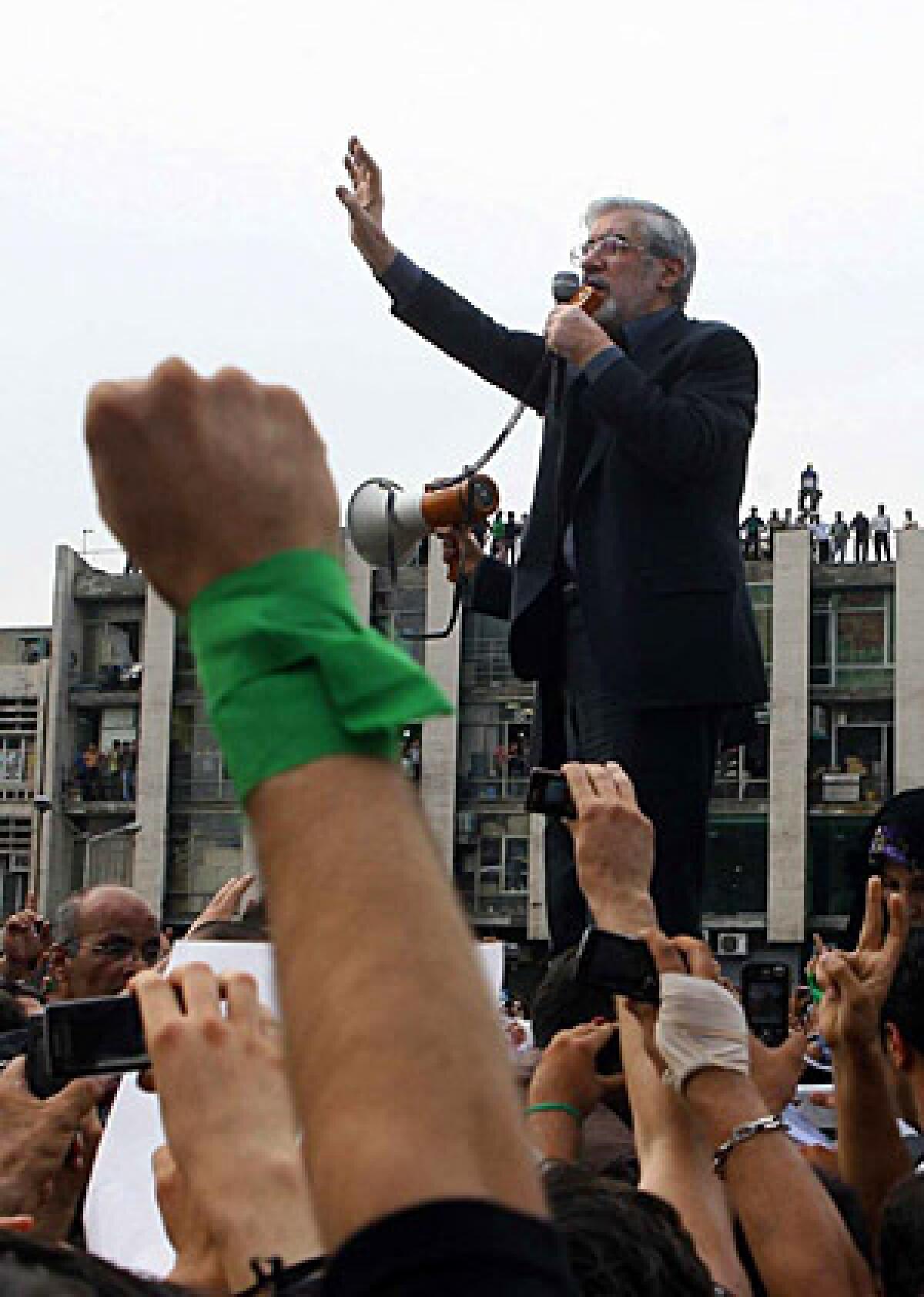In this Sunday’s Books: ‘Death to the Dictator!’ by Afsaneh Moqadam

- Share via
Death to the Dictator!
A Young Man Casts a Vote in Iran’s 2009 Election and Pays a Devastating Price
Afsaneh Moqadam
Sarah Crichton Books/Farrar, Straus & Giroux: 150 pp., $22
After a botched election last year decried as fraudulent by the opposition, millions of Iranians eager for change poured into the streets in largely peaceful protests that rocked the nation’s leadership, challenged Western conceptions about the Islamic Republic and dramatically increased international interest in Iran.
In response, the government imposed a massive and violent crackdown to end the demonstrations, made thousands of arrests, locked down information flows in and out of the country, pushed out or restricted longtime Iran journalists and created a tense calm.
Countless purveyors of facts and analysis have poured into the gap between actual information about Iran and heightened interest. Careful consumers of news have learned to sift through sources, ignoring certain analysts, reading others for historical insight and paying close attention to a select few on the ground in Iran or who have good sources there.
Of course, no one bears more responsibility for the dearth of credible information than the Islamic Republic’s policymakers, who have systematically barred responsible, accountable and independent seekers of truth. The government’s unwillingness to compromise with its domestic opponents has sent tens of thousands abroad over the years in an exodus of talent.
Just as Picasso showed “Guernica” in Paris, so too have Iranians turned abroad to offer totems of anger. “Death to the Dictator!” is the story of a young man who joined the protest movement, and was imprisoned and tortured by authorities. The names of the young man, here called Mohsen Abbaspour, and others in the book have been changed. So has the name of the author, who uses the nom de plume Afsaneh Moqadam.
Described as not particularly politically inclined, Abbaspour experiences the weeks-long buildup to election day on June 12, 2009, and the letdown and eruption of fury afterward. During one protest, he’s arrested and hauled away to an unnamed prison, perhaps Evin in Tehran, where he’s interrogated and beaten, and then to another facility, perhaps the Kahrizak detention center, where he’s raped.
Abbaspour’s tale is interspersed with relatively sound analysis of contemporary Iran’s political and social mechanics. “Until recently internal enemies were tactfully unnamed,” Moqadam writes of hardliners’ shifting rhetoric toward their opponents. “Now for the first time, the schisms have been acknowledged and the reformists are publicly accused of being counterrevolutionaries.”
A 13-page account of infamous protests in which the activist Neda Agha-Soltan died, allegedly at the hands of a Basiji militiaman, rings particularly true.
Perhaps the book’s greatest flaw is the black-and-white picture it paints of Iran’s kaleidoscopic social tapestry. Iran is enormously dynamic and complex. But the author draws emotionally charged and distorted caricatures of the hardliners and their minions who have the upper hand:
“He’s a squat, muscular man of about 45, bearded and covered in sweat, wearing a white shirt, and his forehead has a perfectly centered disk of calloused skin from excessive prayer,” goes the description of one of the regime’s enforcers. “He inhabits a constellation of atmospheres … that consists of the Revolutionary Guard, the Basij, the police, the Ministry of Intelligence, and the judiciary.”
In reality, the Basiji militiaman’s cousin might be one of the protesters, whose father works at a Revolutionary Guard-linked firm where he socializes with a hard-partying tech guy who just returned from a couple of years in Dubai, where his best friend was the son of a monarchist who hobnobs in Los Angeles with Iranian Jews who give to AIPAC.
In fact, one of the survivors of Kahrizak was a photojournalist who covered the Iran- Iraq war, where he met and befriended the then-president who would become Supreme Leader Ali Khamenei. Another was the son of a prominent scientist who served as a campaign advisor for a former Revolutionary Guard commander and conservative politician. And yet another was the nephew of one of President Mahmoud Ahmadinejad’s security chiefs. You get little sense of that in “Death to the Dictator!” Much of the narrative, though often compelling, demonizes a government that is already among the most despised on Earth, adding to an atmosphere that could potentially cloud policy decisions on Iran.
And sometimes the book offers blatantly questionable assessments about a people who can’t speak for themselves. “The more they think about Russia’s alliance with the Islamic Republic, the more the people find that it stinks,” Moqadam writes. “The Russians use their status as a permanent member of the United Nations Security Council to prevent the imposition of effective sanctions.” In fact, many Iranians, including those in the opposition, believe that economic sanctions will neither improve human rights nor convince the government to give up its nuclear enrichment program.
There are quibbles with the facts. Fear, not anger, was the palpable emotion at opposition campaign offices as election day drew to a close, as it became clear that something ugly was underway. And Abbaspour was supposedly arrested at a small Aug. 5 demonstration, taken to a prison where he was beaten and interrogated and then to another facility where he was raped before being released Aug. 29.
But by Aug. 5, Khamenei had already ordered the shutdown of the infamous Kahrizak facility, where rapes had allegedly taken place, and officials had announced the arrest of three prison employees on abuse charges. Opposition leader Mehdi Karroubi had already caused a sensation by alleging rapes inside Kahrizak. Was the facility used after Khamenei’s announcement? Did rapes continue after Karroubi’s explosive disclosure, perhaps at a different facility?
The reader never learns why a pseudonym was “adopted to protect the identity of the author.” The book reveals nothing that has not already been reported by news organizations and human rights watchdogs. Does the author live in Iran? Travel frequently there? All these are relevant factors in evaluating the text.
Though flawed nonfiction, “Death to the Dictator!” will shape the image of Iran for the billions who don’t live there. Iranian authorities dismiss such tomes at their own peril.
daragahi@latimes.com
Daragahi is The Times’ Beirut bureau chief.
More to Read
The biggest entertainment stories
Get our big stories about Hollywood, film, television, music, arts, culture and more right in your inbox as soon as they publish.
You may occasionally receive promotional content from the Los Angeles Times.










